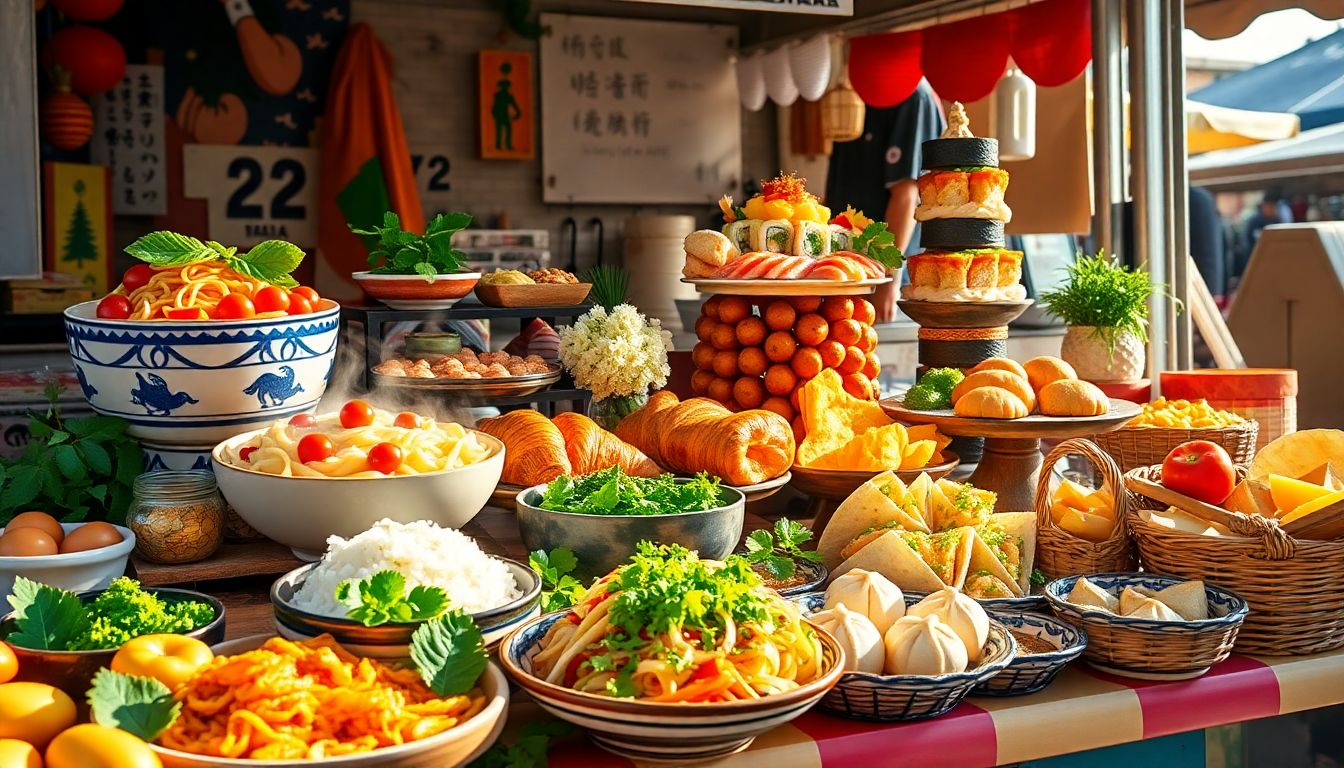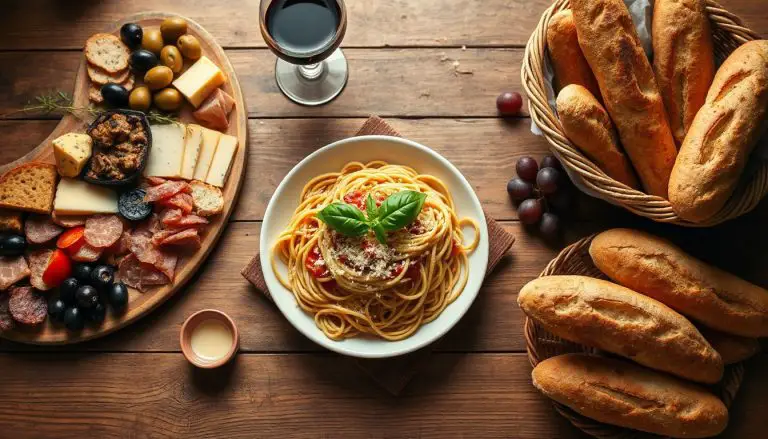The Most Famous Tourist Dishes in International Cuisines

Introduction
Culinary tourism draws travelers who want more than just sights—they crave authentic flavors. Food connects us to cultures, sharing stories through recipes that have been passed down for generations. Think about how a simple dish can tell you everything about a place’s history and traditions. For tourists, famous dishes are often the main reason they visit certain destinations. Food lovers, meanwhile, see tasting local cuisine as a way to truly experience a culture. Knowing these iconic dishes helps you explore authentically—and makes your travels even more exciting.
The Magic of Italian Cuisine: Pizza and Pasta
The Origins and Evolution of Pizza and Pasta
Italy shines as a food destination thanks to pizza and pasta. People first fell in love with pizza in Naples, where it was born in the 18th century. Today, pizza comes in many styles, but Neapolitan remains the most loved—think thin crust, fresh tomatoes, and mozzarella. Pasta, on the other hand, has a long history, with shape varieties linked to different regions. From spaghetti to penne, each type carries a story of regional traditions and ingredients.
Iconic Dishes and Their Cultural Significance
The Margherita pizza isn’t just tasty—it’s Italy’s flag on a crust. Named after Queen Margherita, it features basil, mozzarella, and tomatoes. Classic pasta dishes like Carbonara, Bolognese, and Cacio e Pepe represent Italy’s rich culinary palette. Each one reflects local flavors, from Roman sauces to Bologna’s hearty meat ragù.
Unique Regional Variations
Neapolitan pizza earned UNESCO World Heritage status for its perfection. Northern Italy’s pasta is often creamy and cheese-rich, while southern dishes tend to be spicier and tomato-based. Exploring these regional differences shows how geography influences taste. When traveling, seek out local pizzerias and trattorias for a genuine experience.
Tips for Food Tourists
To enjoy authentic Italian pizza and pasta, look for small, family-run restaurants. Avoid chain outlets—they often serve generic flavors. Use local guides or reviews to find spots loved by locals. If you see “trattoria autentica” or “ristorante di famiglia,” you’re on the right track.
Asian Flavors: Sushi, Dim Sum, and Beyond
Sushi: Japan’s Global Ambassador
Sushi is a symbol of Japanese cuisine that’s loved worldwide. Originally a preservation method, it evolved into a sophisticated art form. Nigiri, sashimi, and maki each offer a different sushi experience—raw fish on rice, slices of fish alone, or rolled with vegetables. Genuine sushi isn’t just about ingredients; it’s about respect and craftsmanship. Know the etiquette, like not mixing wasabi directly into soy sauce, to enjoy sushi the authentic way.
Dim Sum and Chinese Culinary Heritage
Dim Sum has roots in Cantonese tradition, offering bite-sized snacks served in small steamer baskets or on plates. Common items include dumplings, buns, and rolls filled with meat or veggies. Regional differences exist—Shanghai’s soup dumplings differ from Cantonese shumai. Chinese street markets buzz with colorful stalls that burst with flavors and aromas.
Other Notable Asian Dishes
Thailand’s Pad Thai combines sweet, sour, salty, and spicy flavors in a quick stir-fry. Tom Yum soup is famous for its zesty, tangy broth. Indian biryani blends fragrant rice with spices and meat. Exploring street food stalls uncovers a treasure trove of regional specialties.
Tips for Travelers
Look for local food stalls or small family-run restaurants for authentic Asian dishes. If dining in Japan, watch how chefs prepare sushi—they take pride in every piece. In Bangkok or Delhi, ask for dishes the locals love most—they’re usually the most flavorful. Remember, the freshest ingredients make all the difference.
French Elegance: Croissants, Coq au Vin, and Cheese
Classic French Breakfasts and Pastries
French mornings start with flaky croissants and warm pain au chocolat. The art of making them relies on perfect layering and butter. Regional bread varies too—baguettes in Paris, fougasse in Provence. Savoring fresh bread and pastry gives you a taste of French craftsmanship.
French Main Courses and Haute Cuisine
Coq au Vin, a chicken stew cooked with wine, and Bouillabaisse, a hearty fish soup from Marseille, showcase France’s rustic roots. These dishes highlight techniques like braising and simmering—skills shared worldwide in French-style restaurants. French culinary techniques influence kitchens everywhere, elevating simple ingredients.
Cheese and Desserts
French cheeses include Brie, Camembert, and Roquefort, each with a distinct flavor. Top French desserts, like Crème Brûlée and delicate Macarons, balance sweetness with finesse. Visitors often seek cheese tastings and pastry shops to dive into France’s gourmet offerings.
Tips for Food Lovers
For an authentic French experience, visit fromagerie, patisseries, and bistros in Paris or small towns. Look for places that serve regional specialties to get the real taste of France. Outside France, seek restaurants emphasizing simple, fresh ingredients prepared with genuine techniques.
Latin American Delights: Tacos, Feijoada, and Churrasco
Mexican Tacos and Street Food Culture
Tacos are Mexico’s culinary icon, with countless regional styles. From carnitas in Michoacán to al pastor in Mexico City, fillings vary widely. Corn tortillas are traditional, often filled with spicy salsas, onions, and cilantro. Street vendors serve them fast, fresh, and full of flavor.
Brazilian Feijoada and Churrasco
Feijoada, a black bean stew with meat, is Brazil’s hearty national dish. Typically served with rice, collard greens, and orange slices, it reflects African influences. Churrasco, or Brazilian barbecue, features skewered meats grilled over open flames. It’s a social, lively way to enjoy meat—often shared among friends and family.
Other Regional Staples
In Argentina, asado (barbecue) unites family and friends around a grill. Empanadas are popular snacks filled with meat, cheese, or veggies. Peru offers ceviche—fresh raw fish cured in citrus juice with chili and onions—highlighting the region’s seafood riches.
Actionable Tips for Tourists
In Mexico, try tacos from local taquerias for genuine flavors. In Brazil, join a churrasco restaurant or an outdoor barbecue event. Always ask locals for their favorite spots—authentic dishes often come from small, family-run places. Pay attention to ingredients and cooking styles to truly appreciate Latin American cuisine.
Middle Eastern and Mediterranean Treasures: Kebabs, Hummus, and More
Popular Middle Eastern Dishes
Kebabs, shawarma, and falafel are staples across Middle Eastern countries. Each nation tweaks recipes—Lebanon’s kebabs are famous for their spices, while Turkey’s shish kebabs are a staple street food. Street vendors and traditional restaurants serve these with pita bread and fresh veggies.
Mediterranean Classics
Hummus, tabouleh, and souvlaki are Mediterranean favorites, blending fresh herbs, olive oil, and spices. These dishes often originate from ancient traditions, still enjoyed today. A Mediterranean meal often involves sharing multiple small plates to experience a variety of flavors.
Unique Flavors and Ingredients
Spice blends like sumac, za’atar, and saffron add depth and aroma. Vegetarian and vegan options thrive, thanks to the region’s abundant plant-based ingredients. These flavors and ingredients make the cuisine versatile and perfect for all diets.
Tips for Food Enthusiasts
When abroad, seek out local markets or small eateries for the best Middle Eastern and Mediterranean dishes. Look for places that serve original recipes handed down over generations. For an adventurous palate, try dishes with unfamiliar spices—you’re in for a flavor adventure.
Conclusion
Iconic dishes do more than fill your stomach—they tell stories of history, culture, and tradition. Exploring these famous foods opens doors to understanding the world better. They help us appreciate different ways of life and celebrate diversity.
Travelers seeking authentic experiences should always try to find local favorites—small eateries, food tours, or guided recommendations make all the difference. So, next time you visit a new country, look beyond the landmarks. Dive into the flavors and uncover what makes each cuisine unique. Your taste buds—and your mind—will thank you.







